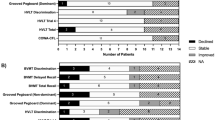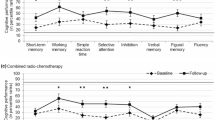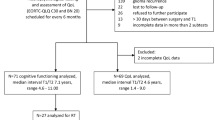Abstract
Background
The role of radiotherapy and chemotherapy in the treatment of low-grade gliomas (LGG) is controversial regarding their effect on survival and the development of neurotoxicity. The few published studies examining adverse treatment effects on cognition revealed conflicting results.
Objective
To assess cognitive functioning in LGG patients who received conformal radiation therapy (RT), chemotherapy, or no treatment.
Design
40 LGG patients participated in the study; 16 patients had RT ± chemotherapy, and 24 patients had no treatment. All patients underwent a neuropsychological evaluation. APOE genotype was obtained in 36 patients who were classified in two groups based on the presence or absence of at least one apolipoprotein E є-4 (APOE є-4) allele.
Results
Treated LGG patients had lower scores than untreated patients on several cognitive domains; patients who completed treatment at intervals greater than 3 years and had long disease duration had significantly lower scores on the Non-Verbal Memory domain. Antiepileptic polytherapy, treatment history, and disease duration jointly contributed to low Psychomotor domain scores. 62% of treated patients showed white matter confluence on MRI, whereas only 9% of the untreated patients had such changes. Preliminary comparisons between APOE є-4 carriers (n = 9) and non-carriers (n = 27) on cognitive domain scores revealed no statistically significant differences, but APOE є-4 carriers had lower mean scores on the Verbal Memory domain than did non-є-4 carriers.
Conclusions
RT ± chemotherapy, disease duration, and antiepileptic treatment contributed to mild cognitive difficulties in LGG patients.
Similar content being viewed by others
References
Guthrie BL, Laws ER Jr (1990) Supratentorial low-grade gliomas. Neurosurg Clin N Am 1:37–48
Davis FG, Freels S, Grutsch J, Barlas S, Brem S (1998) Survival rates in patients with primary malignant brain tumors stratified by age and tumor histological type: an analysis based on surveillance, epidemiology, and end results (SEER) data, 1973–1991. J Neurosurg 88:1–10
Olson JD, Riedel E, DeAngelis LM (2000) Long-term outcome of low-grade oligodendroglioma and mixed glioma. Neurology 54:1442–1448
Levin VA (1996) Controversies in the treatment of low-grade astrocytomas and oligodendrogliomas. Curr Opin Oncol 8:175–177
Lunsford LD, Kondziolka D (2001) Adverse long-term effects of brain radiotherapy in adult low-grade glioma patients. Neurology 57:2150–2151
Buckner JC, Gesme D Jr, O’Fallon JR et al (2003) Phase II trial of procarbazine, lomustine, and vincristine as initial therapy for patients with low-grade oligodendroglioma or oligoastrocytoma: efficacy and associations with chromosomal abnormalities. J Clin Oncol 21:251–255
Stieber VW (2001) Low-grade gliomas. Curr Treat Options Oncol 2:495–506
Shaw EG (1995) The low-grade glioma debate: evidence defending the position of early radiotherapy. Clin Neur 42:448–494
Shaw EG, Tatter SB, Lesser GJ et al (2004) Current controversies in the radiotherapeutic management of adult low-grade glioma. Semin Oncol 31:653–658
Lindegaard KF, Mork SJ, Eide GE et al (1987) Statistical analysis of clinicopathological features, radiotherapy, and survival in 170 cases of oligodendroglioma. J Neurosurg 67:224–230
Karim AB, Afra D, Cornu P et al (2002) Randomized trial on the efficacy of radiotherapy for cerebral low-grade glioma in the adult: European Organization for Research and Treatment of Cancer study 22845 with the Medical Research Council study BR04: an interim analysis. Int J Radiat Oncol 52:316–324
Karim AB, Maat B, Hatlevoll R et al (1996) A randomized trial on dose–response in radiation therapy of low-grade cerebral glioma: European Organization for Research and Treatment of cancer (EORTC) Study 22844. Int J Radiat Oncol 36:549–556
Karim AB, Cornu P, Bleehen N et al (1998) Immediate postoperative radiotherapy in low-grade glioma improves progression free survival, but not overall survival: preliminary results of an EORTC/MRC randomized phase III study. Proc Am Soc Clin Oncol 17:400A
Brown PD, Buckner JC, Uhm JH, Shaw EG (2003) The neurocognitive effects of radiation in adult low-grade glioma patients. Neuro-Oncology 5:161–167
Taphoorn MJB, Schiphorst AK, Snoek FJ et al (1994) Cognitive functions and quality of life in patients with low-grade gliomas: the impact of radiotherapy. Ann Neurol 36:48–54
Armstrong CL, Corn BW, Ruffer JE et al (2000) Radiotherapeutic effects on brain function: double dissociation of memory systems. Neuropsychiatry Neuropsychol Behav Neurol 13:101–111
Armstrong CL, Hunter JV, Ledakis GE et al (2002) Late cognitive and radiographic changes related to radiotherapy. Neurology 59:40–48
Postma TJ, Klein M, Verstappen CCP et al (2002) Radiotherapy-induced cerebral abnormalities in patients with low-grade glioma. Neurology 59:121–123
Surma-aho O, Niemela M, Vikki J et al (2001) Adverse long-term effects of brain radiotherapy in adult low-grade glioma patients. Neurology 56:1285–1290
Vigliani MC, Sichez N, Poisson M, Delattre JY (1996) A prospective study of cognitive functions following conventional radiotherapy for supratentorial gliomas in young adults: 4-year results. Int J Radiat Oncol 35:527–533
Pignatti F, van den Bent M, Curran D et al (2002) Prognostic factors for survival in adult patients with cerebral low-grade glioma. J Clin Oncol 20:2076–2084
Klein M, Engelberts NHJ, van der Ploeg HM et al (2003) Epilepsy in low-grade gliomas: the impact on cognitive function and quality of life. Ann Neurol 54:514–520
Ahles TA, Saykin AJ, Noll WW et al (2003) The relationship of APOE genotype to neuropsychological performance in long-term cancer survivors treated with standard dose chemotherapy. Psycho-Oncol 12:612–619
Richard F, Amoyel P (2001) Genetic susceptibility factors for Alzheimer’s disease. Eur J Pharmacol 412:1–12
Nicoll JAR, Roberts GW, Graham DI (1995) Apolipoprotein E ε-4 allele is associated with deposition of amyloid ε-4-protein following head injury. Nat Med 1:135–137
Jordan BD, Kanik AB, Horwich MS et al (1995) Apolipoprotein E ε-4 and fatal cerebral amyloid angiopathy associated with dementia pugilistica. Ann Neurol 38:698–699
Kutner KC, Erlanger DM, Tsai J, Jordan B, Relkin N (2000) Lower cognitive performance of older football players possessing apolipoprotein E ε-4. Neurosurgery 47:651–658
Tardiff BE, Newman MF, Saunders AM (1997) Preliminary report of a genetic basis for cognitive decline after cardiac operations. Ann Thorac Surg 64:715–720
Lezak MD (1995) Neuropsychological assessment, 3rd edn. Oxford University Press, New York
Weitzner MA, Meyers CA, Gelke CK, Byrne KS, Cella DF, Levin VA (1995) The Functional Assessment of Cancer Therapy (FACT) Scale: development of a brain subscale and revalidation of the general version (FACT-G) in patients with primary brain tumors. Cancer 75:1151–1161
Hixson JE, Vernier DT (1990) Restriction isotyping of human apolipoprotein E by gene amplification and cleavage with HhaI. J Lipid Res 31:545–548
Crook R, Hardy J, Duff K (1994) Single-day apolipoprotein E genotyping. J Neurosci Meth 53:125–127
Fazekas F, Chawluk JB, Alavi A, Hurtig HI, Zimmerman RA (1987) MR signal abnormalities at 1.5 T in Alzheimer’s␣dementia and normal aging. Am J Neuroradiol 8:421–426
Weitzner MA, Meyers CA (1997) Cognitive functioning and quality of life in malignant glioma patients: a review of the literature. Psycho-Oncol 6:169–177
Correa DD, DeAngelis LM, Shi W et al (2004) Cognitive functions in survivors of primary central nervous system lymphoma. Neurology 62:548–555
Klein M, Heimans JJ (2004) The measurement of cognitive functioning in low-grade glioma patients after radiotherapy. J Clin Oncol 22:966–967
Fjell AM, Walhovd KB, Reinvang I et al (2005) Age does not increase rate of forgetting over weeks—neuroanatomical volumes and visual memory across the adult life-span. J Int Neuropsych Soc 11:2–15
Tulving E, Markowitsch HJ, Craik FIM et al (1996) Novelty and familiarity activations in PET studies of memory encoding and retrieval. Cereb Cortex 6:71–79
Martin A (1999) Automatic activation of the medial temporal lobe during encoding: lateralized influences of meaning and novelty. Hippocampus 9:62–70
Goldberg E, Podell K, Lovell M (1994) Lateralization of frontal lobe functions and novelty. J Neuropsych Clin Ni 6:371–378
Benedict RHB, Bakshi R, Simon JH et al (2002) Frontal cortex atrophy predicts cognitive impairment in multiple sclerosis. J Neuropsychiatry Clin N 14:44–51
Tullberg M, Fletcher E, DeCarli E et al (2004) White matter lesions impair frontal lobe function regardless of their location. Neurology 63:246–253
Aldenkamp AP (2001) Effects of antiepileptic drugs on cognition. Epilepsia 41:46–49
Laack NN, Brown PD, Furth A et al (2003) Neurocognitive function after radiotherapy (RT) for supratentorial low-grade gliomas (LGG): results of a north central cancer treatment group (NCCTG) prospective study. Int J Radiat Oncol 57:S134
Torres IJ, Mundt AJ, Sweeney PJ et al (2003) A longitudinal neuropsychological study of partial brain radiation in adults with brain tumors. Neurology 60:1113–1118
Bondi MW, Salmon DP, Monsch AU et al (1995) Episodic memory changes are associated with the APOE-epsilon 4 allele in nondemented older adults. Neurology 46:2203–2206
Flory JD, Manuck SB, Ferrell Re et al (2000) Memory performance and the apolipoprotein E polymorphism in a community sample of middle-aged adults. Am J Med Genet 96:707–711
Nilsson LG, Nyberg L, Backman L (2002) Genetic variation in memory functioning. Neurosci Biobehav Review 26:841–848
Caselli RJ, Osborne D, Reiman EM et al (2001) Preclinical cognitive decline in late middle-aged asymptomatic apolipoprotein E-e4/4 homozygotes: a replication study. J Neurol Sci 189:93–99
Smith GE, Bohac DL, Waring SC et al (1998) Apolipoprotein E genotype influences cognitive phenotype in patients with Alzheimer’s disease but not in healthy control subjects. Neurology 50:355–362
Hyman BT, Gomez-Isla T, Briggs M et al (1996) Influence of APOE genotype on developing cognitive impairment in the general population. Ann Neurol 40:55–66
Greenberg SM, Hyman BT (1997) Cerebral amyloid and Apolipoprotein E: bad news for the good allele? Ann Neurol 41:716–721
Sugihara S, Ogawa A, Nakazaro Y et al (1995) Cerebral B amyloid deposition in patients with malignant neoplasms: its prevalence with aging and effects of radiation therapy on vascular amyloid. Acta Neuropathol 90:135–141
Behin A, Delattre JY (2003) Neurologic sequelae of radiotherapy of the nervous system. In: Schiff D, Wen PY (eds) Cancer neurology in clinical practice. Humana Press, Totowa, pp 173–192
Acknowledgments
The authors thank Aviva Glass, Angeles Cheung, and Jocelyn Dantis for their assistance with data acquisition and management.
Author information
Authors and Affiliations
Corresponding author
Additional information
Supported by a research grant from the Charles Dana Foundation to Dr. Denise D. Correa.
Presented in part at the American Academy of Neurology Annual Meeting in April 2004, and at the World Federation of Neuro-Oncology (WFNO) II/ European Association for Neuro-Oncology VI Meeting in May 2005.
Rights and permissions
About this article
Cite this article
Correa, D.D., DeAngelis, L.M., Shi, W. et al. Cognitive functions in low-grade gliomas: disease and treatment effects . J Neurooncol 81, 175–184 (2007). https://doi.org/10.1007/s11060-006-9212-3
Received:
Accepted:
Published:
Issue Date:
DOI: https://doi.org/10.1007/s11060-006-9212-3




